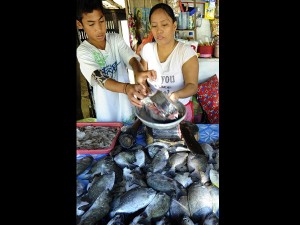
Malaga (siganid), caught in the waters off Zambales, are sold in a market in Sual, Pangasinan. EV ESPIRITU/INQUIRER NORTHERN LUZON
DAGUPAN CITY, Philippines—After successfully breeding in captivity two malaga (siganid or rabbit fish) species, scientists here are now creating a hybrid species by crossbreeding the spotted (Siganus guttatus) and striped (Siganus vermiculatus) malaga.
Westly Rosario, chief of the National Integrated Fisheries Technology Development Center (NIFTDC) in Barangay Bonuan Binloc here, said the crossbreeding was conducted in an effort to create a species that would benefit malaga growers.
“The challenge to us, scientists, is to shorten the larva-rearing period of malaga, increase its survival rate and improve its growth performance,” Rosario said.
Malaga is an expensive but tasty, fleshy fish usually served broiled, sinigang (with sour broth) or paksiw (cooked in vinegar) in popular restaurants in the country.
These are grown in ponds in Pangasinan, in cages in Davao and Caraga and in pens in Eastern Visayas.
Rosario said malaga has a 60-day larva-rearing period, compared, for instance, to sea bass, which takes only 21 days, or to bangus (milkfish), which takes only 18 days.
He said although malaga is a high-value fish species, it grows slowly, taking four to five months before it can be harvested and sold in the market.
In crossbreeding, Rosario said his team first mated a female striped malaga with a male spotted malaga. Then they reversed the combination, this time with a female spotted malaga and male striped malaga.
“It’s actually a breakthrough,” Rosario said, noting that it was the first time the two species were successfully crossbred in captivity.
He said among the initial findings is that the hybrid species develops faster.
“We take pictures of the fingerlings through the microscope every day,” said Rosario.
In 2010, Rosario said, the NIFTDC successfully bred in captivity the two commercial malaga species and has distributed at least 40,000 fingerlings to fish farmers in Binmaley and Lingayen towns since then.
He said scientists from the World Fish Center and the Department of Science and Technology visited malaga farms in Binmaley last year to observe the species’ culture.
“Some of them prefer to raise the guttatus (spotted variety) because according to them, it’s heavier. The others prefer the vermiculatus (striped variety) because it grows faster,” Rosario said.
“So, we thought, what if we create a hybrid? Will the two species mate? We tried this two weeks ago and it was successful,” he said.
Rosario said among the many species of fish for aquaculture, malaga is ideal because it eats planktons.
“Of all fish, malaga is just like a goat, just leave it there and it grows. So, even scientists from developed countries are now focused on malaga as an aquaculture species,” he said.
Rosario said to date, the Philippines remains the leading malaga producer in the world, with 226 metric tons of production in 2007. Saudi Arabia follows with only 15 MT.